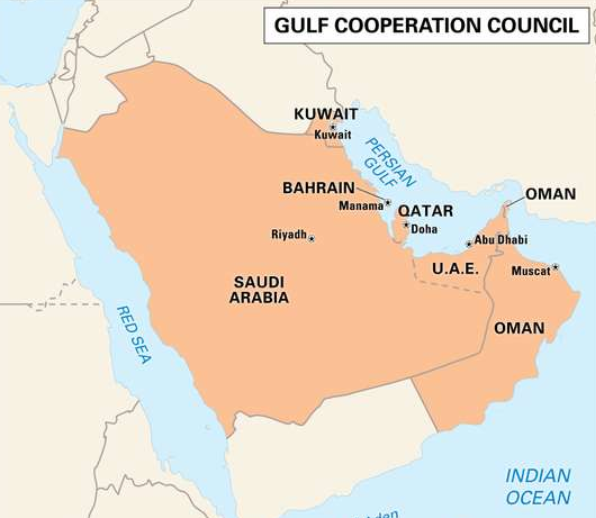International Relations
India & Gulf Countries
This article is based on “Time to bridge the Gulf” which was published in The Indian Express on 24/11/2020. It talks about the ongoing transformation in the gulf region and the opportunity for India.
Recently, India’s External Affairs Minister visited Bahrain and the United Arab Emirates. The visit reflects the growing importance of gulf countries in India’s foreign policy.
For decades, India’s saw the Gulf countries largely from the economic prism, as a source of oil and a destination for labour exports. However, over the last few years, this economic prism has morphed into a strategic embrace.
Present Prime Minister’s personal outreach to the Gulf rulers has helped crack open immense possibilities for political and strategic cooperation. This elevation of India’s strategic priorities vis-a-vis the Gulf countries reflects on the structural changes taking place in the Gulf and the region’s growing influence in the Indian Ocean.
Transformation of Gulf Region
- No Longer Exclusive Petro-States: The Gulf states are no longer seen as a collection of petro-states, now they have established a strong structure of finance capital built on the massive accumulation of oil revenues over the last few decades.
- This has given rise to what is today called “Khaleeji” or Gulf capitalism.
- Khaleeji Capitalism: It is a concept developed by Adam Hanieh, a scholar based in London’s School of Oriental and African Studies Capitalism, which tracks the rise of large conglomerates and sovereign wealth funds in the Gulf.
- It is due to this capitalism model the gulf countries dominate several regional sectors — from banking and finance to infrastructure and logistics, from agribusiness and real estate to retail to telecom.
- Further, the growing financial clout of the Gulf countries has also begun to translate into expansive geopolitical influence in the Middle East and the Indian Ocean.
- Moving Towards Modernisation: Gulf countries, in the present times, seek to reduce the heavy hand of religion on social life, expand the rights of women, widen religious freedoms, promote tolerance, and develop a national identity that is not tied exclusively to religion.
- The UAE has been the leader in this regard. It has initiated reforms including the decriminalisation of alcohol use, permission for cohabitation among unmarried couples, criminalisation of honour crimes against women, and the institution of long-term visas.
- De-hyphenation of India-Pakistan: Today, the Gulf countries are eager to build strong and independent political ties with India, without getting affected by the India-Pakistan relations.
India’s Relations with the Gulf Countries
- Political: The governments of the Gulf countries are India-friendly and Indian-friendly.
- Recently, the Prime Minister of India has received the ‘Order of Zayed’, the highest civilian order of the UAE and the ‘King Hamad Order of the Renaissance’, the third-highest civilian order of Bahrain.
- In the recent past, Saudi Arabia and the UAE have not adopted hostile posture to India’s domestic developments such as removing the special status for Jammu & Kashmir under Article 370.
- Economic: The Gulf countries are among India’s key suppliers of energy and annual remittances from Indians.
- The United Arab Emirates (UAE) and Saudi Arabia are India’s third and fourth-largest trading partners respectively and the total bilateral trade of the Gulf countries with India for the year 2018-19 stood at USD 121.34 billion.
- UAE also features in the top 10 sources of FDI inflows into India.
Way Forward
- Shielding India’s Economic Interest: First and foremost, Indian foreign policy should shield India’s interests in the post-pandemic turbulence.
- Due to economic instability caused by the pandemic, the Gulf countries are considering cutting back on foreign labour.
- India should ensure that the Indian expatriates will not be affected by this.
- Focusing Beyond Oil: There is a need to focus on the new and long-term possibilities for economic cooperation with the Gulf countries, which is looking at a future beyond oil.
- The Gulf states have embarked on massive economic diversification and are investing in a variety of new projects including renewable energy, higher education, technological innovation, smart cities, and space commerce.
- India must get its businesses to focus on the range of new opportunities in the Gulf.
- India also needs to tap into the full possibilities of Gulf capital for its own economic development. The big gap between the investments that the Gulf is ready to offer and India’s ability to absorb needs to be reduced.
- In 2015, the UAE committed to investing $75 billion in India. However, there is still a long distance away from facilitating that scale of investments.
- Leveraging Gulf-Israel Normalisation: Earlier this year, UAE and Bahrain have normalised relations with Israel. This provides an opportunity for India to increase economic and technological engagement with Israel.
- Getting Along With Khaleeji Capitalism: With the rise of Khaleeji capitalism, the Gulf countries today deliver economic and security assistance to friendly states, build ports and infrastructure, acquire military bases and broker peace between warring parties and states.
- The UAE currently chairs the Indian Ocean Rim Association (IORA) and has been eager to work with India in developing joint infrastructure projects.
- India needs to bring scale and depth to its regional initiatives on connectivity and security in the Indian Ocean.
Conclusion
The Middle East has become more multipolar, with power diffused among a variety of regional and extra-regional actors. Within this mix, the rise of modern values and Khaleeji Capitalism in the gulf countries make the case for India to discard outdated perceptions of the Gulf and seize the new strategic possibilities with the region.
|
Drishti Mains Question The elevation of India’s strategic priorities vis-a-vis the Gulf countries reflects on the structural changes taking place in the Middle East. Discuss. |
This editorial is based on “Clearing the air with President-elect Biden” which was published in The Economic Times on November 24th, 2020. Now watch this on our Youtube channel.





